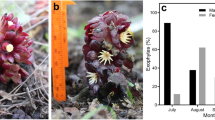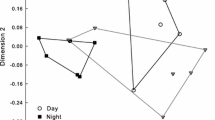Abstract
Bulbophyllum is the largest orchid genus with > 2000 species. There are many daciniphilous Bulbophyllum species with unique lip mechanisms for fly pollination. Their flowers exclusively attract pest and non-pest Dacini fruit fly species via fragrant floral synomones containing at least one major male attractant. Bulbophyllum hortorum bears non-resupinate and solitary flowers. The four-year study showed that anthesis normally started at dawn; and every flower closed nightly and reopened the next morning (if pollinarium is not removed previously). The flowers attracted many raspberry ketone-responsive fruit fly species. In Malaysia, eleven Dacini species were attracted, of which six species with light-weight males (< 13 mg) were unable to open the small close-spring lip (CSL), thereby, they are not potential pollinators but mere floral visitors. The other five species had individuals sufficiently heavy to overcome the CSL’s torsional force (equivalent to a mean weight of 13 mg) to open the CSL; and also with some lighter males unable to pry open the CSL, thereby, rendering them floral visitors and not potential pollinators. The CSL moved slowly towards the column in the afternoon before the flower closed for the night. Besides selecting for an adequately heavy male fly to be a potential pollinator, the CSL has the vital role of catapulting the fly in to the column cavity, thereby, enhancing spontaneous pollinarium removal. The unique dynamic lip mechanism and the ‘stopper’ (the tip of column-foot which maintains the temporarily opened CSL in a horizontal position) may be pre-adaptations to floral resupination in B. hortorum.













Similar content being viewed by others
Data availability
Not applicable.
References
Baker HG (1963) Evolutionary mechanisms in pollination biology: origins and functions of floral systems are being elucidated by genetical and ecological studies. Science 139(3558):877. https://doi.org/10.1126/science.139.3558.877
Borba EL, Semir J (1998) Wind-assisted fly pollination in three Bulbophyllum (Orchidaceae) species occurring in the Brazilian campos rupestres. Lindleyana 13:203–218
Christensen DE (1994) Fly pollination in the Orchidaceae. In: Arditti J (ed) Orchid Biology, Reviews and Perspectives VI. Wiley, New York, pp 415–454
Davies KL, Stpiczyńska M (2014) Labellar anatomy and secretion in Bulbophyllum Thouars (Orchidaceae: Bulbophyllinae) sect. Racemosae Benth. & Hook. F Annals of Botany 114:889–911. https://doi.org/10.1093/aob/mcu153
Doorenweerd C, Leblanc L, Norrbom AS, San Jose M, Rubinoff D (2018) A global checklist for the 932 fruit fly species in the tribe Dacini (Diptera: Tephritidae). Zookeys 730:19–56. https://doi.org/10.3897/zookeys.730.21786
Doorenweerd C, San Jose M, Gib S, Dupus J, Leblanc L, Barr N, Fiegalan E, Morris KY, Rubinoff D (2022) A phylogenomic approach to species delimitation in the mango fruit fly (Bactrocera frauenfeldi) complex: a new synonym of an important pest species with variable morphotypes (Diptera: Tephritidae). Syst Entomol—Early View—Online Version. https://doi.org/10.1111/syen.12559
Dressler RL (1990) The Orchids, Natural History and Classification. Harvard University Press, Cambridge, p 332
Flügel H-J (2013) The Sepsidae from the ‘Lebendiges Bienenmuseum’ (Diptera) and her flower visit in Middle Europe (in German). Phillipia 16:81–93
Frodin DG (2004) History and concepts of big plant genera. Taxon 53:753–776. https://doi.org/10.2307/4135449
Jersakova J, Johnson SD, Kindlmann P (2006) Mechanisms and evolution of deceptive pollination in orchids. Biol Rev 81:219–235. https://doi.org/10.1017/S1464793105006986
Kaiser R (1993) The scents of orchids, olfactory, and chemical investigations. Elsevier, The Netherlands
Kastinger C, Weber A (2001) Bee-flies (Bombylius spp., Bombyliidae, Diptera) and the pollination of flowers. Flora Jena 196:3–25. https://doi.org/10.1016/S0367-2530(17)30015-4
Katte T, Tan KH, Su ZH, Ono H, Nishida R (2020) Floral fragrances in two closely related fruit fly orchids, Bulbophyllum hortorum and B. macranthoides (Orchidaceae): assortments of phenylbutanoids to attract tephritid fruit males. Appl Entomol Zool 55(1):55–64. https://doi.org/10.1007/s13355-019-00653-x
Khoo CCH, Tan KH (2000) Attraction of both sexes melon fruit fly, Bactrocera cucurbitae, to conspecific males - a comparison after pharmacophagy of cue-lure and a new attractant—zingerone. Entomol Exp Appl 97:312–320. https://doi.org/10.1046/j.1570-7458.2000.00745.x
Larson BMH, Kevan PG, Inouye DW (2001) Flies and flowers: taxonomic diversity of anthophiles and pollinators. Can Entomol 133:439–465. https://doi.org/10.4039/Ent133439-4
Lord EM, Russell SD (2002) The mechanisms of pollination and fertilization in plants. Annual Review Cell Developmental Biology 18:81–105. https://doi.org/10.1146/annurev.cellbio.18.012502.083438
Nakahira M, Ono H, Wee SL, Tan KH, Nishida R (2018) Floral synomone diversification of two Bulbophyllum sibling species (Orchidaceae) in attracting fruit fly pollinators (Diptera: Tephritidae). Biochem Syst Ecol 81:86–95. https://doi.org/10.1016/j.bse.2018.10.002
Nishida R, Iwahashi I, Tan KH (1993) Accumulation of Dendrobium (Orchidaceae) flower fragrance in the rectal glands by males of the melon fly, Dacus cucurbitae (Tephritidae). J Chem Ecol 19:713–722. https://doi.org/10.1007/BF00985003
Nishida R, Tan KH, Wee SL, Hee AKW, Toong YC (2004) Phenylpropanoids in the fragrance of the fruit fly orchid, Bulbophyllum cheiri, and their relationship to the pollinator, Bactrocera papayae. Biochem Syst Ecol 32:245–252. https://doi.org/10.1016/S0305-1978(03)00179-0
Nishida R, Tan KH (2016) Search for new fruit fly attractants from plants: A review. 249–262. In Sabater-Munoz, B., Vera, T., Pereira, R. and Orankanok, W. (eds.) Proceedings of the 9th International Symposium on Fruit Flies of Economic Importance, 12–16 May 2014, Bangkok, Thailand
Nishida R, Howcroft NH, Tan KH, Su ZH, Ono H (2022) Floral synomone components of fruit fly-attracting orchids, Bulbophyllum sinapis and B. hahlianum, in Papua New Guinea. Biochem Syst Ecol. https://doi.org/10.1016/j.bse.2022.104481
Ong PT (2013) The pollination of two Bulbophyllum species. Orchid Rev 121(1303):152–155
Ong PT, Tan KH (2011) Fly pollination in four Malaysian species of Bulbophyllum (Section Sestochilus) – B. lasianthum, B. lobbii, B. subumbellatum and B. virescens. Males Orchid J 8:103–110
Ong PT, Hee AKW, Wee SL, Tan KH (2011) The attraction of flowers of Bulbophyllum (Section Sestochilus) to Bactrocera fruit flies (Diptera: Tephritidae). Males Orchid J 8:93–102
Radian FX, Padmarsari W (2012) Pollination biology of orchids of the genus Bulbophyllum in Labian-Leboyan Corridor. pp 109–112. In: Widmann P, Tiju A, Putra MH, Syahirsyah, Wulffraat S (eds.) Connecting Diversity – People and Nature of Labian-Leboyan Corridor in the Indonesian Heart of Borneo. WWF-Indonesia. www.hobgreeneconomy.org/downloads/Connectingdiversity_peo pleandnature.pdf
Ridley HN (1890) On the method of fertilization in Bulbophyllum macranthum, and allied orchids. Ann Bot 4:327–336. https://doi.org/10.1093/oxfordjournals.aob.a090567
Royer JE, Tan KH, Mayer DG (2020) Trap catches of male Bactrocera and Zeugodacus fruit flies (Diptera: Tephritidae) with four floral phenylbutanoids (anisyl acetone, cue-lure, raspberry ketone and zingerone) in Australia. Environ Entomol 49:815–822. https://doi.org/10.1093/ee/nvaa056
Sazima M (1978) Polinizac¸a˜o por moscas em Bulbophyllum warmingianum Cogn. (Orchidaceae), na Serra de Cipo´, Minas Gerais. Brasil Revista Brasileira De Botaˆnica 1:133–138
Schiestl FP, Peakall R, Mant JM, Ibarra F, Schulz C, Franke S, Francke W (2003) The chemistry of sexual deception in an orchid wasp pollination system. Science 302:437–438. https://doi.org/10.1126/science.1087835
Tan KH (2009) Fruit fly pests as pollinators of wild orchids. Orchid Digest 73:180–187
Tan KH, Nishida R (2000) Mutual reproductive benefits between a wild orchid, Bulbophyllum patens, and Bactrocera fruit flies via a floral synomone. J Chem Ecol 26:533–546. https://doi.org/10.1023/A:1005477926244
Tan KH, Nishida R, Toong YC (2002) Floral synomone of a wild orchid, Bulbophyllum cheiri, lures Bactrocera fruit flies for pollination. J Chem Ecol 28:1161–1172. https://doi.org/10.1023/A:1016277500007
Tan KH, Nishida R (2005) Synomone or Kairomone?—Bulbophyllum apertum (Orchidaceae) flower releases raspberry ketone to attract Bactrocera fruit flies. J Chem Ecol 31(3):509–519. https://doi.org/10.1007/s10886-005-2023-8
Tan KH, Tan LT, Nishida R (2006) Floral phenylpropanoid cocktail and architecture of Bulbophyllum vinaceum orchid in attracting fruit flies for pollination. J Chem Ecol 32:2429–2441. https://doi.org/10.1007/s10886-006-9154-4
Tan KH, Nishida R (2007) Zingerone in the floral synomone of Bulbophyllum baileyi (Orchidaceae) attracts Bactrocera fruit flies during pollination. Biochem Syst Ecol 35:334–341. https://doi.org/10.1016/j.bse.2007.01.013
Tan KH, Nishida R (2012) Methyl eugenol—its occurrence, distribution, and role in nature, especially in relation to insect behavior and pollination. J Insect Sci 12(56):1–74. https://doi.org/10.1673/031.012.5601
Tan KH, Nishida R (2013) Pollination of bactrocerophilous Bulbophyllum Orchids. In: Elliott J, Kurzweil HF, O'Byrne P, Tan KW, van der Schans AS, Wong SM, Yam TM (eds.) Proceedings of the 20th World Orchid Conference, Singapore Botanic Gardens, Singapore, p 273–279.
Tan KH, Tan LT (2018) Movements of floral parts and roles of the tooth on the column wall of Bulbophyllum praetervisum (Orchidaceae) flower in pollination by Dacini fruit flies (Diptera: Tephritidae). J Pollinat Ecol 24:157–163. https://doi.org/10.26786/1920-7603(2018)19
Tan KH, Wee SL, Nishida R, Shelly TE (2021a) Attraction of feral Bactrocera dorsalis males (Diptera: Tephritidae) to Bulbophyllum cheiri (Orchidaceae) flowers versus synthetic methyl eugenol. J Asia-Pacific Entomol 24:1095–1100. https://doi.org/10.1016/j.aspen.2021.10.008
Tan KH, Vermeulen JJ, Katte T, Ono H, Nishida R (2021b) Diversification in both the floral morphology and chemistry in two daciniphilous orchid ecotypes in Borneo. Arthropod-Plant Interact 15:447–455. https://doi.org/10.1007/s11829-021-09821-9
Teixeira SDEP, Borba EL, Semir J (2004) Lip anatomy and its implications for the pollination mechanisms of Bulbophyllum species (Orchidaceae). Ann Bot 93:499–505. https://doi.org/10.1093/aob/mch072
van der Cingel NA (2001) An alas of orchid pollination America, Africa, Asia, Australia A.A. Balkema. Rotterdam, The Netherlands
van der Pijl L, Dodson CH (1969) Orchid flowers, their pollination and evolution, 2nd edn. University of Miami Press, Florida, p 214
Wee SL, Royer JE, Herring J, Meyer DG, Tan KH (2020) Relative response of male Bactrocera frauenfeldi (Diptera: Tephritidae) to phenylbutanoid phytochemicals: implications for fruit fly control and plant-insect interactions. Chemoecology 30:305–314. https://doi.org/10.1007/s00049-020-00320-6
Woodcock TS, Larson BMH, Kevan PG, Inouye DW, Lunau K (2014) Flies and flowers II: floral attractants and rewards. J Pollinat Biol 12:63–94. https://doi.org/10.26786/1920-7603(2014)5
Acknowledgements
We are grateful to L.C. Sim for her assistance and moral support. We thank S.L. Wee, Universiti Kebangsaan Malaysia, Selangor, Malaysia, for identifying the three Bactrocera neocognata specimens captured in Kajang, Selangor.
Author information
Authors and Affiliations
Corresponding author
Ethics declarations
Conflict of interest
The authors declare that there is no conflict of interest.
Additional information
Handling Editor: Dagmar Voigt.
Publisher's Note
Springer Nature remains neutral with regard to jurisdictional claims in published maps and institutional affiliations.
Rights and permissions
Springer Nature or its licensor (e.g. a society or other partner) holds exclusive rights to this article under a publishing agreement with the author(s) or other rightsholder(s); author self-archiving of the accepted manuscript version of this article is solely governed by the terms of such publishing agreement and applicable law.
About this article
Cite this article
Tan, K.H., Ong, P.T. & Tan, L.T. Morphology and movement of Bulbophyllum hortorum (Orchidaceae) flowers enable selection of optimal-sized Dacini fruit fly males as pollinators. Arthropod-Plant Interactions 17, 647–660 (2023). https://doi.org/10.1007/s11829-023-09987-4
Received:
Accepted:
Published:
Issue Date:
DOI: https://doi.org/10.1007/s11829-023-09987-4




